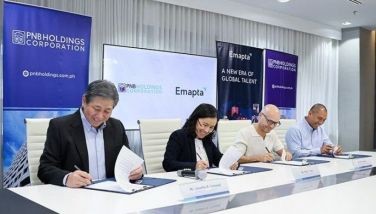‘Government winning war vs COVID’

MANILA, Philippines — The country is winning the war against the coronavirus disease 2019 (COVID-19), according to the chief implementer of the government’s response to the pandemic.
“For two months that we implemented the enhanced community quarantine, where are we now? I am happy to tell my beloved countrymen that we are winning in our continuous fight against this pandemic,” Carlito Galvez Jr., chief implementer of the National Task Force on COVID-19 response, said on Friday.
Galvez said that based on results of earlier tests, the country recorded 250 new cases for every 11,509 daily tests conducted.
He said that between March and April, 13 percent of those tested turned out to be positive cases.
“If we will compare it to our data today, the number of cases decreased by eight percent,” Galvez said.
“We also have 89 advanced stage 3 and 4. Our death rates also continue to decrease based on data. In April, we recorded 50 patients who died in one day. But in May, from double-digit death rates, it was reduced to a single digit. We are targeting to reduce it to zero deaths per day,” Galvez said.
He said the country’s testing capacity is also expected to further improve, with the accreditation of 39 laboratories all over the country.
“We are trying our best to increase this number. Of the present number of laboratories, 21 are in the National Capital Region, six in different parts of Luzon, seven in the Visayas and five in Mindanao,” Galvez said. There are 119 pending applications for accreditation of testing labs, he added.
He also reported rising number of patient recoveries. “The highest number of patients recovered on May 13 was 145 in one day. We continue to strengthen our health facilities to address the needs of COVID-19 patients. As of May 20, we have 1,500 referral and treatment hospitals which have 10,572 total bed capacity,” Galvez said.
He also disclosed that the government now has 3,146 “Ligtas COVID-19 centers” for persons under monitoring, suspect, probable and confirmed cases nationwide. The centers can accommodate 57,773 patients.
He said that based on Department of Health (DOH) report, the country now has 13,295 hospital beds nationwide for COVID-19 cases, 69.9 percent of which are isolation beds, 20.3 percent ward beds for confirmed COVID-19 cases and 9.7 percent dedicated ICU beds.
“As of May 20, 5,143 beds are occupied which means that the country’s hospitals are ready and enough for the treatment of confirmed COVID-19 cases which need immediate and serious medical attention,” Galvez said.
PPE supply stable
Galvez also revealed that as of May 14, the government has stabilized the supply and demand for personal protective equipment (PPE) in the country.
“In the entirety, we have distributed 700,000 level 4 PPEs in different COVID-19 referral hospitals nationwide. Aside from this, local government units are also buying their own PPEs while the private sector has distributed two million PPEs in different public and private hospitals in the country,” Galvez said.
As part of its preparation for 2021, the government is stockpiling 11 million complete PPE sets to ensure the safety of frontliners.
“We distributed 8,200 medical grade PPE sets, 200 sets of RT-PCR kits capable of testing 10,000 and 1,300 rapid test kits for the medical frontliners in the Cordillera Administrative Region,” Galvez said.
“To address the needs of OFWs, we will put testing laboratories in Clark, Pampanga and Davao. We are trying our best to have RT-PCR machines in each region for the incoming OFWs, especially in regions with direct international flights,” Galvez said.
He also thanked various groups like the MVP Group, Philippine National Red Cross, San Miguel Corp. and United Laboratories for their contribution to the government’s initiatives to combat COVID-19 and ease its impact on livelihood.
“The NCR has 16.5 million population with 843 deaths compared to Lombardy, Italy with 10.06 million population only but it has 32,330 deaths. New York which has 19 million population has 61,000 deaths,” Galvez said.
Declining cases
Like Galvez’s statement, a University of the Philippines report also showed declining COVID-19 cases in the country since the start of the enhanced community quarantine (ECQ).
Based on Forecast No. 7 of UP’s COVID-19 Forecasts in the Philippines: Post-ECQ Report, “the value of R for the entire Philippines has been decreasing” since the ECQ was implemented last March 16. “R” pertains to rate of spread of the disease.
And in a number of provinces around the country, the report showed, the spread of COVID-19 is “either controlled or in a decelerating trend.”
“The ECQ has been working. The past ECQ has been critical in reducing transmission and deaths due to COVID-19 in the Philippines. We know this because the reproduction number R, which measures the rate of spread of the pandemic, has been decreasing since the beginning of ECQ,” the report stated.
The report further indicated that reproduction number R has been decreasing since April 1, from 2.5 to less than 1 currently.
“The decrease in the reproduction number may be solely attributed to the ECQ, despite some challenges the nation faced with regard to mass testing and contact tracing,” it showed.
The report, however, does not mean that the positive trend is “irreversible.”
According to the report, the nationwide trend only shows the average for the entire country. Trends vary according to region, province and local government unit (LGU).
The report said for NCR and Cebu City, the number of new COVID-19 cases is still very high, “so the risk level of the pandemic is still high.” This means the transmission of the virus in the country is “not yet controlled.”
“Mobility and proximity to other people are drivers of the COVID-19 pandemic. Considering that NCR is one of the most densely populated areas in the world … reducing mobility and proximity in NCR is a challenge,” it noted.
The report also noted “still significant” risk levels in Batangas, Davao City and Zamboanga City. These areas should be monitored closely in the next weeks.
It also pointed out the need to monitor Samar and Oriental Mindoro as new cases appeared in the two provinces recently.
“This means that we cannot afford to be complacent, even in areas where the pandemic appears to be contained, because it takes just one spreader to start a second wave of the pandemic,” the report added. Sheila Crisostomo
- Latest
- Trending






























